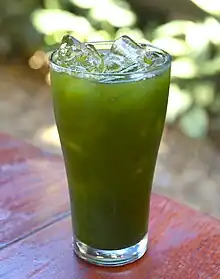Centella asiatica
Centella asiatica, commonly known as Indian pennywort and Asiatic pennywort, is a herbaceous, perennial plant in the flowering plant family Apiaceae.[2] It is native to tropical regions of Africa, Asia, Australia, and islands in the western Pacific Ocean.[2][3][4][5] It is consumed as a culinary vegetable and is used in traditional medicine.[2]
| Centella asiatica | |
|---|---|
_(3).jpg.webp) | |
| Scientific classification | |
| Kingdom: | Plantae |
| Clade: | Tracheophytes |
| Clade: | Angiosperms |
| Clade: | Eudicots |
| Clade: | Asterids |
| Order: | Apiales |
| Family: | Apiaceae |
| Genus: | Centella |
| Species: | C. asiatica |
| Binomial name | |
| Centella asiatica | |
| Synonyms[2] | |
Description
Centella grows in temperate and tropical swampy areas in many regions of the world.[2] The stems are slender, creeping stolons, green to reddish-green in color, connecting plants to each other.[2] It has long-stalked, green, rounded apices which have smooth texture with palmately netted veins.[2] The leaves are borne on pericladial petioles, around 2 cm (0.79 in). The rootstock consists of rhizomes, growing vertically down. They are cream in color and covered with root hairs.[2]
The flowers are white or crimson in color, born in small, rounded bunches (umbels) near the surface of the soil.[2] Each flower is partly enclosed in two green bracts. The hermaphrodite flowers are minute in size, less than 3 mm (0.12 in), with five to six corolla lobes per flower. Each flower bears five stamens and two styles. The fruit are densely reticulate, distinguishing it from species of Hydrocotyle which have smooth, ribbed or warty fruit.[5] The crop matures in three months, and the whole plant, including the roots, is harvested manually. It is a highly invasive plant, rated as "high risk".[2] Centella has numerous common names in its regions of distribution.[2]

Ecology
Habitat
Centella asiatica is indigenous to the Indian subcontinent, Southeast Asia, parts of Australia, and wetland regions of the Southeastern US.[6][7] Because the plant is aquatic, it is especially sensitive to biological and chemical pollutants in the water, which may be absorbed into the plant. It can be cultivated in drier soils as long as they are watered regularly enough (such as in a home garden arrangement).
Composition
Chemistry
Centella contains pentacyclic triterpenoids and trisaccharide derivatives, including asiaticoside, brahmoside, asiatic acid, and brahmic acid (madecassic acid). Other constituents include centellose, centelloside, and madecassoside.[8][9][10]
Uses
Culinary
In Burmese cuisine, raw pennywort is used as the main constituent in a salad mixed with onions, crushed peanuts, bean powder and seasoned with lime juice and fish sauce.[11] Centella is used as a leafy green in Sri Lankan cuisine, being the predominantly locally available leafy green, where it is called gotu kola. It is most often prepared as malluma, a traditional accompaniment to rice and vegetarian dishes, such as dal, and jackfruit or pumpkin curry. It is considered nutritious. In addition to finely chopped gotu kola plants, the gotu kola malluma may be eaten with grated coconut, diced shallots, lime (or lemon) juice, and sea salt. Additional ingredients are finely chopped green chilis, chili powder, turmeric powder, or chopped carrots. The Centella fruit-bearing structures are discarded from the gotu kola malluma due to their intense bitter taste. A variation of porridge known as kola kenda is also made with gotu kola in Sri Lanka. Gotu kola kenda is made with well-boiled red rice with some extra liquid, coconut milk first extract, and gotu kola purée. The porridge is accompanied with jaggery for sweetness. Centella leaves are also used in modern sweet pennywort drinks and herbal teas. In addition the leaves are served stir-fried whole in coconut oil, or cooked in coconut milk with garlic or dhal.

In Indonesia, the leaves are used for sambai oi peuga-ga, an Aceh type of salad, and is also mixed into asinan in Bogor. In Cambodia, Vietnam and Thailand, this leaf is used for preparing a drink or can be eaten in raw form in salads or cold rolls. In Bangkok, vendors in the Chatuchak Weekend Market sell it alongside coconut, roselle, chrysanthemum, orange and other health drinks. In Malay cuisine it is known as pegaga, and the leaves of this plant are used for ulam, a type of vegetable salad.[2] C. asiatica is widely used in various Indian regional cuisines. In Bangladesh and India (specifically in West Bengal), Centella is called Thankuni Pata and used in various dishes, one of the most appetising of which is the pakora-like snack called Thankuni Patar Bora; made of mashed Centella, lentils, julienned onion and green chilli.
Traditional medicine
In traditional medicine, C. asiatica has been used to treat various disorders and minor wounds,[2] although clinical efficacy and safety have not been scientifically confirmed.[12] Contact dermatitis and skin irritation can result from topical application.[12] Drowsiness may occur after consuming it.[12] The herb may have adverse effects on liver function when used over many months.[12]
Soil remediation
In the context of phytoremediation, C. asiatica is a potential phytoextraction tool owing to its ability to take up and translocate metals from root to shoot when grown in soils contaminated by heavy metals.[13]
Gallery
 Emerging flowers
Emerging flowers.jpg.webp) Flower, close-up
Flower, close-up Centella asiatica, India
Centella asiatica, India A patch of Centella Asiatica or pegaga in Malay
A patch of Centella Asiatica or pegaga in Malay
References
- Lansdown, R.V. (2019). "Centella asiatica". IUCN Red List of Threatened Species. 2019: e.T168725A88308182. doi:10.2305/IUCN.UK.2019-2.RLTS.T168725A88308182.en. Retrieved 19 November 2021.
- "Centella asiatica (Asiatic pennywort)". Invasive Species Compendium, CABI. 22 November 2017. Archived from the original on 23 July 2017. Retrieved 2 January 2018.
- "Centella asiatica (L.) Urb". Plants of the World Online. Royal Botanic Gardens, Kew. Retrieved 12 February 2022.
- United States Department of Agriculture. "Plant Profile for Centella asiatica". Retrieved 15 July 2012.
- Floridata. "Centella asiatica". Retrieved 15 July 2012.
- "Centella asiatica". Alabama Plant Atlas. Retrieved 17 August 2015.
- "Centella asiatica". Atlas of Florida Vascular Plants. Retrieved 17 August 2015.
- Singh, Bhagirath; Rastogi, R.P. (May 1969). "A reinvestigation of the triterpenes of Centella asiatica". Phytochemistry. 8 (5): 917–921. doi:10.1016/S0031-9422(00)85884-7.
- Singh, Bhagirath; Rastogi, R.P. (August 1968). "Chemical examination of Centella asiatica linn—III". Phytochemistry. 7 (8): 1385–1393. doi:10.1016/S0031-9422(00)85642-3.
- Joseph E. Pizzorno, Michael T. Murray (2012). Textbook of natural medicine (4th ed.). Edinburgh: Churchill Livingstone. p. 650. ISBN 9781437723335.
- "A selection of classic Burmese dishes". Travelfish. Retrieved 2021-01-09.
- "Gotu kola". Drugs.com. 23 January 2023. Retrieved 21 September 2023.
- Abd. Manan, Fazilah; Chai, Tsun-Thai; Abd. Samad, Azman; Mamat, Dayangku Dalilah (1 April 2015). "Evaluation of the Phytoremediation Potential of Two Medicinal Plants". Sains Malaysiana. 44 (4): 503–509. doi:10.17576/jsm-2015-4404-04.
